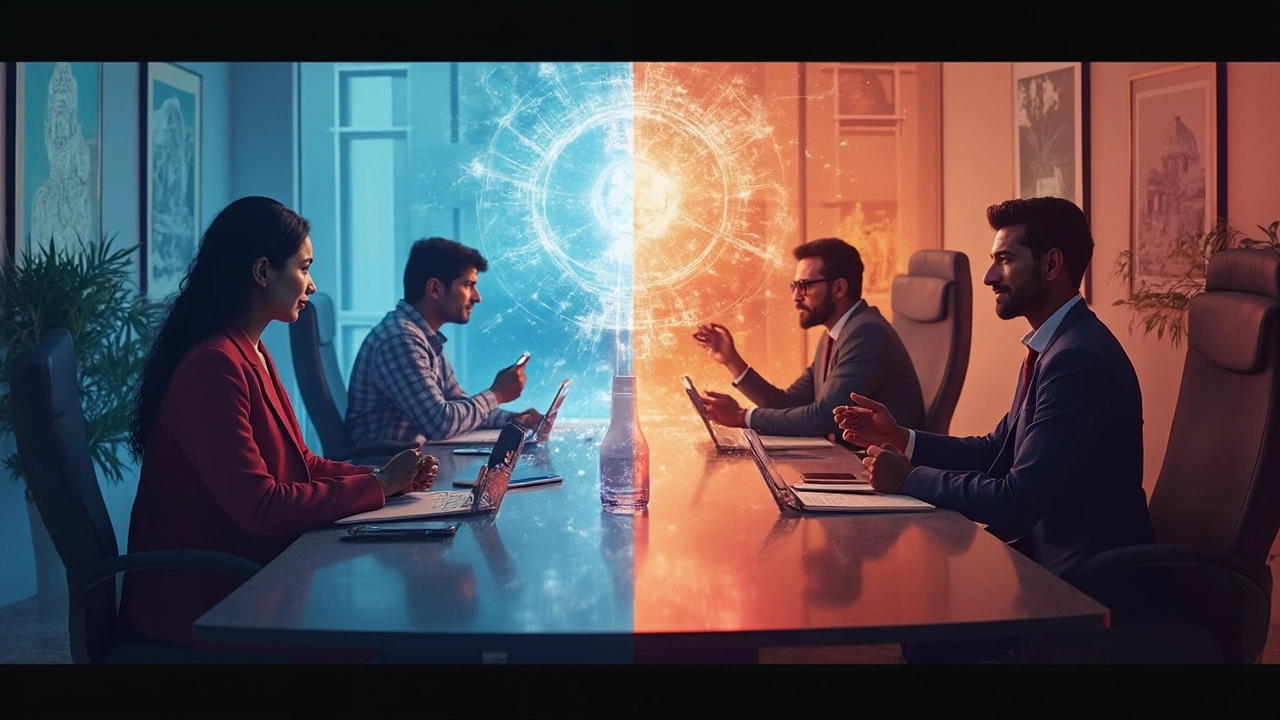
So, you're thinking about upgrading your phone, but you're not sure if sticking with the iPhone is the best choice, right? Well, you're not alone. The smartphone market in 2025 is buzzing with options that might just sway your decision. Sure, iPhones are iconic, but some Android devices are really giving them a run for their money.
Why might you consider a different brand? For starters, let's chat about innovation. Brands like Samsung and Google are packing their phones with some jaw-dropping features. Ever heard of foldable screens? They're not just a gimmick anymore; they're improving each year. Not to mention the crazy-good performance that some of these devices bring to the table with their processing power.
But what about what's inside? How fast your apps run, how sharp your photos look, and how often you need to plug into a charger—all those things matter too. Believe it or not, in some of these areas, Android phones are leading the pack. Plus, if you're one for customization, some Android interfaces let you tinker and tailor your phone's personality straight out of the box. Let's dive into details and see how these phones can actually make life easier.
- Game-Changing Features
- Performance and Speed
- Camera Capabilities
- Battery Life
- User Experience and Value
Game-Changing Features
Alright, let's get into it. What's setting some of these top smartphone contenders apart from the iPhone? One of the biggest trends right now is foldable technology. Samsung's latest Galaxy Z Fold, for instance, isn't just a novelty item; it gives you the flexibility (literally) to use a phone that's also a mini tablet. Imagine browsing a website on a nice big screen and then folding it back into your pocket—pretty slick!
Display Advancements
If you're all about the screen quality, check out phones with OLED displays. Brands like Samsung and Huawei are pushing the boundaries with crazy vibrant colors and deep blacks. You won't just see a photo; you'll feel like you're looking through a window into another world. Plus, with refresh rates now hitting as high as 120Hz, smooth scrolling and gaming are better than ever.
Sound and Gaming
For the audiophiles out there, some of these Android alternatives come equipped with stereo speakers that make a real difference. The Google Pixel, for instance, is often praised for its crisp sound quality. Gaming on phones like the ASUS ROG Phone is also a whole new experience with dedicated game modes and advanced cooling systems.
The difference? It's not just about bragging rights; these features genuinely enhance the way you use your phone daily. Whether you're multitasking like a pro, watching Netflix on the go, or just chilling with your favorite playlist, these smartphones offer experiences that sometimes leave the iPhone in the dust.
Innovative Software
Let's talk software: Google Pixel's Android experience offers some super handy features that aren't just there for show. The Google Assistant is smart—and I mean, really smart. It can schedule calls, send messages, play your favorite song, and more—all with a simple voice command. It's like having a little assistant in your pocket. If customization is your thing, Android has it in spades, allowing you to fit the phone just to your liking.
Performance and Speed
Let's talk speed. When you're in the market for a new phone, performance is a big deal, and it usually boils down to the processor. These days, phones like the Samsung Galaxy S25 and the Google Pixel 9 are equipped with processors that match, if not surpass, the iPhone's latest chips.
The Samsung Galaxy S25 features the Exynos 10000 (or Snapdragon 8 Gen 3, depending on the region), which has been making waves in benchmark scores. They aren't just about numbers, though. These chips allow for smooth multitasking, amazing graphics for mobile games, and lag-free video streaming, all crucial for staying productive or entertained on the go.
iPhone alternatives like the OnePlus 13 have also stepped up with cutting-edge chips. Their OxygenOS platform is highly optimized for speed, making everyday tasks feel seamless. Switch between apps in a snap, or enjoy fast downloads and web browsing with their advanced connectivity features.
More Than Just Speed
But it’s not all about processor speeds and scores. RAM is another player here. Some Android phones come with a whopping 16GB of RAM, compared to iPhone’s usual 6GB or 8GB. More RAM means better handling for intensive apps like photo editors or the latest augmented reality games.
- Smooth multitasking without hiccups
- Faster app launches
- Better data management for a snappy experience
Curious about how these phones handle real-world tasks compared to the iPhone? Let’s throw in some numbers:
| Phone Model | Geekbench Score | RAM (GB) |
|---|---|---|
| iPhone 14 | 7200 | 6 |
| Samsung Galaxy S25 | 7500 | 16 |
| Google Pixel 9 | 7400 | 12 |
These scores reflect how well a phone can handle multiple tasks at once without breaking a sweat. While the iPhone traditionally holds its own, some latest smartphones are showing it’s not the only player in town when it comes to performance and speed. Whether you're keen on editing videos on the fly or immersing in graphics-heavy mobile games, the performance powerhouses we've just talked about might just be worth considering.

Camera Capabilities
Alright, let’s talk about what really captures our attention when it comes to phones—literally. Camera capabilities have stepped up massively, with some smartphone comparison showing that even the latest iPhone is facing stiff competition.
Pixel Power
Take Google's Pixel series, for instance. It's all about that AI magic. The Pixel 7 Pro boasts incredible night mode features that can turn a pitch-black scene into a vibrant photo. Plus, it's got this super smart photo unblur tool, which, as the name suggests, sharpens up those annoying blurry shots that happen when the action gets too frantic.
“Google's AI-driven camera technology makes every moment picture-perfect, setting a new standard in smartphone photography.” — TechCrunch
Zoom Like Never Before
Samsung isn't holding back either. Their Galaxy line provides up to 100x space zoom, which honestly feels like you have a telescope in your pocket. Try spotting a bird on a tree branch from afar, and trust me—this feature will blow your mind with the detail it captures.
Wide and Ultrawide Lenses
One of the things Samsung and Huawei phones nail is versatility. They give you not just standard and telephoto lenses but also impressive ultrawide options. Imagine capturing the entirety of a beautiful landscape without needing to step back like ten feet. It's wild what you can fit into one shot!
To give you a quick peek, here's how some features stack up:
| Phone | Zoom Capability | Low-Light Performance |
|---|---|---|
| iPhone 14 | 5x optical zoom | Good |
| Google Pixel 7 Pro | 30x super res zoom | Excellent |
| Samsung Galaxy S23 Ultra | 100x space zoom | Excellent |
Choosing between these top-tier options often comes down to what you need in a camera. Love taking photos after sunset? Or maybe capturing details from far away is your thing? There's a best phone 2025 for everyone, and sometimes, it might just not be an iPhone.
Battery Life
When it comes to battery life, it's not just about lasting a whole day anymore. People are demanding more, and for good reason. Let's face it—what good is a shiny new phone if it dies before you can show it off at dinner?
One of the key areas where some iPhone alternatives are really shining is battery performance. Many Android devices have been stepping up their game with larger batteries and more efficient processors. Take the Samsung Galaxy S25, for example. It packs a monster 5000mAh battery, giving you more juice to stay unplugged longer.
But it's not just about size. Phone makers like Google with their Pixel series have been optimizing software to squeeze out every extra minute possible. Thanks to clever power-saving tricks, some models can go for over 48 hours with moderate use. Yes, you read that right—two days without a charge!
Fast Charging and Wireless Options
If you're often on the go, fast charging is another feature to watch. Brands like OnePlus have taken this to new levels with technology like Warp Charge, which can give you a day's power in just 30 minutes. Impressive, huh?
And let’s not forget wireless charging. While it's becoming more common, some models offer reverse wireless charging too. Imagine topping up your earbuds right off your phone!
Lastly, when comparing latest smartphones, it's worth considering how battery life integrates with other features. Screens, processors, and other tech affect how long your phone stays alive. In the end, the best phone for you is the one that keeps up with your life without needing constant recharging.

User Experience and Value
When it comes down to it, the way a phone feels in your hand and fits into your life can make or break your choice. While iPhones have a reputation for their sleek design and intuitive interface, some smartphone comparison shows that rivals are catching up, and even surpassing, in the user experience department.
Customizability
Imagine picking up your phone and having an entire interface that mirrors your style. With many Androids, you're not just stuck with factory settings; you can move, resize, and switch up nearly everything. Widgets, custom app icons, and launchers allow users to transform their home screens into something truly unique.
Seamless Integration
Google's ecosystem is becoming tougher to ignore. With seamless integration between devices, switching from your best phones 2025 to a Google Home system feels easy. Even Samsung has improved how their devices sync with other electronics and home appliances, giving Apple a run for its money in household connectivity.
Bang for Your Buck
Not everyone has the budget for a top-of-the-line iPhone. Luckily, many Android alternatives offer premium features without the hefty price tag. Brands like OnePlus and Xiaomi are famous for high specs on a budget, often costing hundreds less yet delivering everything you need (plus some extras you didn't know you wanted).
| Feature | iPhone | Android |
|---|---|---|
| Customization | Limited | Extensive |
| App Stores | Apple Store | Google Play/others |
| Price Range | $$$$ | $ to $$$$ |
Whether you're after specific iPhone alternatives or simply curious about what's out there, exploring these different user experiences and the value offered might open up new possibilities for how you connect with technology every day.